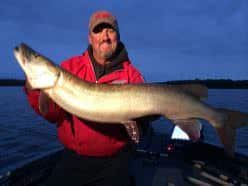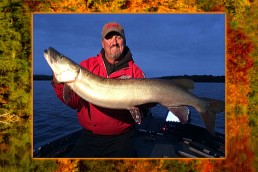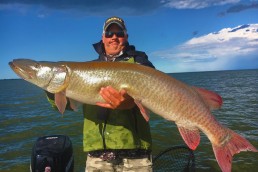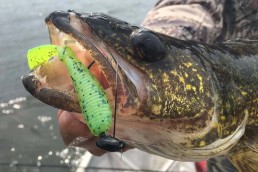One-two Fall Muskie Punch
SHARE THIS POST
One of my favorite television shoots is when I get to fish with my good friend John Mich in northern Wisconsin in the fall. I always know the season is starting to wind down, but it’s also a reminder that it’s “real” muskie season and we are in the heart of autumn. The leaves are either falling or mostly gone and the water temperatures are dropping. We are typically fishing live bait and artificials in tandem, and it seems that every time the bite is either heavy on the live bait or heavy on the artificials.
Last time, John caught a beautiful 50-incher on a sucker while we were checking rods moments just after releasing a 46 incher. It’s crazy, but really symbolic of how fast and furious, and also short-lived, the muskie bite can be on any fall day.
I don’t want to get into fishing live bait other than to say that there is no question that on many fall days it can be extremely effective, and if you are allowed to run multiple lines, I am always a big fan of trailing some “meat” while casting.
Here are my two favorite lures to utilize in fall when fishing live bait. Even if you aren’t into livebait fishing, you should seriously consider fishing with these to score on big fall muskies.
Are you enjoying this post?
You can be among the first to get the latest info on where to go, what to use and how to use it!
When fishing waters 10 feet and shallower in fall—which often means the water is stained, or there has been some sort of warming trend—I always have a rod rigged with a Phantom Soft Tail glider jerkbait. This lure is absolutely incredible for pulling muskies from cover and triggering them to strike. The key is not to overwork these lures in the fall. Just impart a series of taps or short twitches with the rod tip. Also, make sure not to get too methodical in the retrieve. Certainly, you are trying to achieve that classic side-to-side movement of the lure, but you need to break up the cadence to trigger strikes. So, I’ll make sure and pause the bait one or two times each retrieve and give it an extra couple seconds to fall. When the Phantom falls on controlled slack line it shimmies and looks alive; plus, the tail is always moving. So, it’s a prime opportunity for a muskie to pause and strike the lure. At boatside, I typically pause the lure about 10 to 15 feet from the boat to see if a muskie is behind it and will bite on the pause, then I “figure eight” the lure. As long as the tail is moving on the Phantom Softtail, you have a shot at catching one boatside. My favorite colors for these gliders in fall are generally natural such as while, sucker or walleye patterns, but in some dark waters orange or chartreuse really shine.

My other go-to lures in fall for waters 10 feet and much deeper are the Magnum or Pounder Bull Dawg. These work really well when fishing deeper weed edges or breaklines in clearer water lakes depths of 15 to 25 feet. You can get the large soft plastic—which essentially is a large jig with a tail—closer to the deep cover or breakline and get a muskie to react. Long pulls and pauses really get the nod in fall, but like the jerkbait, you’ll need to break up the cadence. Toss in a few shorter “twitches” or a couple hard “rips.”
There’s really no wrong way to fish the Bull Dawg in fall. Just keep in mind to fish it slower and generally a little deeper than you might in mid-summer. Finish off with a big “figure eight” at boatside and hesitate the lure at the outside of the turns to make the Bull Dawg pause and sink before continuing out of the turn. That subtle move often triggers followers to bite. There are lots of Bull Dawg colors, but you really want to keep it simple and make sure you have one that’s primarily black, another that’s primarily gold, and a third that’s primarily white. With those three you can’t go wrong.
Actually, if you are fishing a Phantom and a Bull Dawg and trailing live suckers—or not—you really can’t go wrong this fall. These lures have proven themselves in my boat to work throughout the years, everywhere across the muskie range when the water temperatures drop and the big fall muskies start putting on the feed bag. Fishing this species this season is never easy, but if you keep your presentations simple, and spend more time fishing than running between spots, you might catch your personal best.
MWO
SHARE THIS POST
Did you enjoy this post?
You can be among the first to get the latest info on where to go, what to use and how to use it!
Jim Saric
Jim Saric is a Legendary Angler in the Freshwater Fishing Hall of Fame, the host and executive producer of The Musky Hunter television series, editor at large of Musky Hunter magazine, a seven-time muskie tournament winner, and a contributing writer for numerous other publications.



